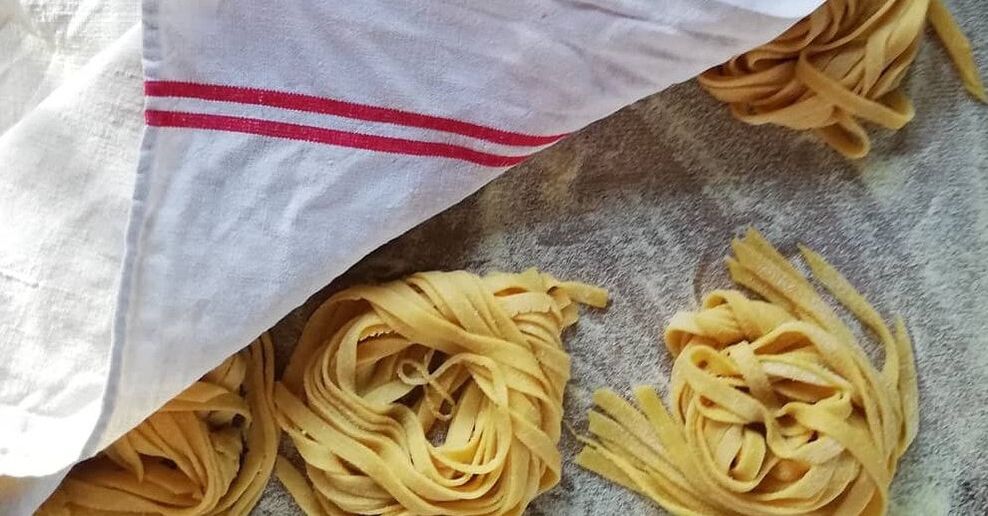 Pasta is a simple flour and liquid (either egg or water) mixture that is kneaded into a stiff dough – an ideal way to use up starter that is a few days old, rather than discarding before you next refresh. This recipe uses liquid starter. If you are keeping a stiff starter, simply adjust the quantities to accommodate (about 15g less flour and add 15g water). If you are making vegan pasta, replace the egg with 100-110g of water. You can make pasta with fine semolina (from the Southern Italian hard or ‘durum’ wheat) or with fine pasta grade ‘00’ flour. I often make mine with a mix of the two. Watch our video tutorial on Youtube here or read below. Basic sourdough pasta dough
(Makes about 450g) Ingredients: ‘00’ flour 100g Semolina 150g Liquid starter 100g Medium eggs 2 Dash of olive oil Method: Mix the semolina and ‘00’ flour in a large bowl. Traditionally, a ‘well’ is made in the middle of the flour into which you can add your liquid starter and eggs. Using a regular knife, dough scraper or simply two fingers, start to mix the dough from the centre, incorporating more of the flour as you stir until you have a stiff dough and all the flour has been absorbed. Add a dash of olive oil and knead in before turning your dough out onto a clean surface. Knead for five or so minutes until you have a smooth and elastic dough. Wrap in cling film and rest for 30 minutes or so. Once rested, dust your counter with semolina before rolling your dough. You can pass through your pasta machine or roll out using a rolling pin. If using a pasta machine, divide into 4 pieces, keeping those you are not yet using wrapped. Pass the first piece through the machine on its thickest setting. Fold the resulting long strip of dough into thirds over itself, turn through 90 degrees and pass through the machine again. You should have a smooth homogeneous strip that you can pass through the machine at successive thicknesses until the desired thickness is reached (usually the thinnest or one above the thinnest setting). Repeat for the 3 other pieces of dough. You will end up with 4 long strips of dough that can be passed through the shaper on your machine to make fettucine, tagliatelle etc. Or you can hand cut as desired. Place the cut and shaped pasta in a bed of semolina or rice flour and give it a fine coating to prevent sticking – if you use regular flour, it will be absorbed and your pasta will stick to itself. If rolling by hand, try and keep an even thickness throughout – you may find it easier to divide your dough into smaller pieces before rolling, until you are more practiced at this. Depending upon the final pasta shape you have chosen, you can hang your pasta or leave on semolina-coated trays, covered with a cloth, ready for when you want to cook. When ready to cook, bring water to boil in your largest pan (which allow the pasta plenty of space to remain separate and the temperature of such a big pot won’t drop so significantly when you add the pasta), throw in some salt and cook for 3-4 minutes only. A simple sauce with oil or butter, will allow you to appreciate the delicious, fresh pasta to the full. Why not try infusing 1 ½ tablespoons of oil per serving with some sliced garlic and some chilli flakes and toss through the drained pasta. Finish with some coarse sea salt, freshly ground black pepper and a scattering of fresh pecorino. Simple and delicious |
Our workshops are run by award-winning sourdough baker Helen Underwood.
Categories
All
Archives
November 2023
|


